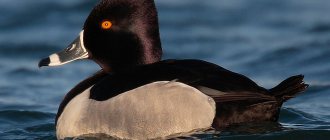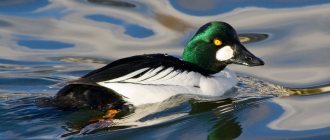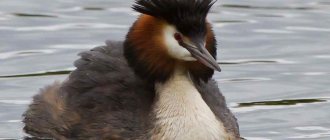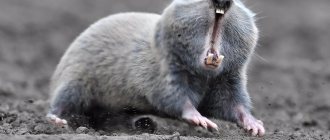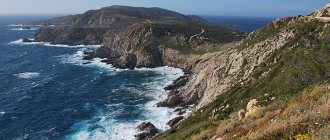- Wild animals
- >>
- Birds
The unusual merganser duck first gained its popularity more than three hundred years ago. It was then that she first appeared in many European countries and immediately became the favorite of their residents. The merganser duck is still highly valued by people today. It is recognized as one of the most beautiful waterfowl. Despite its popularity, few people can boast of at least minimal knowledge about this species of bird.
Origin of the species and description
Photo: Merganser duck
The beautiful wild merganser duck is known not only for its bright and unusual plumage, but also for its impressive size. The weight of these birds can reach two kilograms. The most active weight gain occurs in the fall. Mergansers are migratory birds. In winter, they prefer to move to countries with warm climates. However, in the winter they are often spotted in Kamchatka, Primorye and on the shores of the Azov Sea.
Video: Merganser duck
Merganser ducks belong to the order Anseriformes, a subfamily of true ducks. They are part of the duck family and are separated into a separate genus of mergansers. The reason for the appearance of a separate genus is the presence of a large number of similarities between mergansers of different species. They all have some of the same anatomical features, similar lifestyles, similar behavior and food preferences.
Some common characteristics of mergansers include:
- long, narrow and curved beak. At its top you can see a small horny growth. And instead of standard duck plates on the beak (for collecting plant food), these ducks have sharp teeth. They are located at the edges and are designed to make the fish easier to eat;
- elongated neck, torso. This feature makes them very similar to loons and grebes;
- predominance of fish in the diet. Mergansers practically do not eat plant foods;
- Excellent natural diving ability.
The classification of merganser ducks has changed several times throughout time.
Today it is customary to distinguish four types of mergansers:
- scaly. This is the most ancient species. Half of the body of such a bird resembles the pattern of scales. Such birds live only in the east;
- big. It is the largest representative of mergansers. Very often it is confused with a goose. The Great Merganser nests in both the east and west;
- long-nosed The weight of this animal is one and a half kilograms, the length does not exceed fifty-eight centimeters. This species is the most common and is found throughout the merganser’s habitat;
- Brazilian. The rarest variety - the number does not exceed three hundred and fifty individuals. Breeds only in the west.
Appearance and features
Photo: What a merganser duck looks like
The appearance of merganser ducks depends on their variety. However, there are many anatomical and external similarities between different species. So, all mergansers are distinguished by their impressive dimensions. Their length is, on average, about sixty centimeters. The weight of such birds can reach two kilograms. The wingspan of mergansers exceeds eighty centimeters. However, these are average figures, because in nature there are individuals of smaller dimensions.
Another distinctive feature of mergansers is their narrow and long beak, which is curved at the end. On the sides of such a beak there are small teeth. They help the animal catch and eat fish. These ducks have a long neck, which is not typical for other members of the family. The legs of mergansers are quite short and have a wide leathery blade. The tail is rounded and short. The wings have a pointed shape.
Interesting fact: Unlike other ducks, mergansers are rarely eaten. The meat of these wild ducks can be infected with tapeworms and has an unpleasant odor. A tapeworm can grow up to several meters in the human body.
The most characteristic feature of mergansers is the spectacular color of their feathers. All types of these ducks are painted in very unusual color combinations. Thus, the large merganser is colored black, dark gray, white and pink. The scaly appearance is brown-olive, red or ash-blue. The back of this animal is decorated with gray and white stripes that closely resemble scales. The Brazilian merganser is distinguished by a bright red beak, black head and neck, greenish-brown upper body and light belly.
Where does the merganser duck live?
Photo: Merganser duck in Russia
The merganser duck is considered a migratory bird, but this is not entirely true. Some species prefer to lead a sedentary lifestyle. To live, these birds choose areas with a temperate and warm climate. In summer they live on the Eurasian continent, in its central zone. Mergansers appear there in early spring. They always arrive almost the very first, as soon as it gets a little warmer outside. In winter, animals are the last to leave their usual habitats - when severe cold comes and all water bodies freeze.
Mergansers like to choose forest places for nesting. But occasionally their nests can be found in coastal areas and even in the mountains. Such differences in habitat are associated with the existence of many species and subspecies of mergansers. An important criterion when choosing a place for these birds is the presence of a water source with suitable food nearby. These birds eat fish. The natural habitat of merganser ducks is very extensive, which is due to the presence of different species of birds.
It includes:
- China. Only those places where there are plenty of fish;
- eastern and western hemispheres, Central Asia, Californian lakes, Himalayan mountains. The largest representative of ducks, the great merganser, lives in these territories. Moreover, in some places mergansers live sedentary;
- Far East of Russia, northern Japan, Southeast Asia. This is the natural habitat of scaly-sided mergansers;
- coast of Western Europe, Great Britain. A long-nosed species lives here;
- reservoirs of Paraguay, Argentina, Brazil. This territory is inhabited by the rarest species of mergansers – the Brazilian one.
Now you know where the merganser duck lives. Let's see what this bird eats.
Distribution area
What the breed looks like, photo:
Holarctic species, distribution area - forest-tundra and northern boreal forest of the western and eastern hemispheres.
In Eurasia, it lives mainly east of northern Denmark and Scandinavia, but small populations have been recorded in the Alps, Great Britain and Iceland.
In the north it is found up to the limit of tree vegetation: on the Kola Peninsula and the European part of Russia up to 67° N. sh., on Yamal up to 69° N. sh., on the Yenisei to 68° N. sh., in the Vilyuya basin up to 66° N. sh., in the Lena basin up to 64° N. sh., east to the Kolyma Range to the 64th parallel, to the northern regions of Chukotka.
Habitats of large mergansers
On the American continent it breeds all the way from west to east to north from southern Alaska to Quebec and Newfoundland.
In the Old World, to the south it breeds to northern Denmark, the central regions of Poland and Belarus, the Pskov region, the Mologa River valley, the upper parts of the Belaya, Ufa and Ik river basins, in Western Siberia up to 55° N. sh., east to Lake Zaisan, Altai, northern regions of Mongolia, the southern part of the Amur basin, northeastern China and the southern tip of the Sikhote-Alin mountain range.
In North America south to Northern Mexico on the west coast and the northeastern US states on the east.
Migrations
Migratory or partially migratory species. In winter, northern populations migrate to temperate latitudes: thus, birds nesting in Scandinavia and the polar north-west of Russia mostly move to areas near the coasts of the Baltic or North Seas, but also in smaller numbers to water bodies in Central and Southern Europe.
Small concentrations of wintering birds have been noted in the coastal areas of the Black and Caspian Seas, as well as in Central Asia - according to experts, these birds most likely nest in Russia east of Pechora. In the Far East, wintering sites are located in Japan, Korea and coastal areas of China.
The number of migratory birds fluctuates from year to year: obviously, during mild winters, a significant part of them remain in their nesting areas or migrate over shorter distances. The autumn flight begins only with the arrival of frost, when the water is covered with a thin layer of ice. More southern populations also tend to be sedentary, making vertical migrations or migrating over short distances.
Habitat
During the nesting period, it inhabits freshwater bodies of water with wooded shores: small unovergrown lakes with open reaches, reservoirs, fast-flowing rivers in the upper reaches, where it usually stays close to the shore in the shade of trees.
To take off, the bird requires a fairly large distance on the water - for this reason, it often avoids very small bodies of water, which fully meet all other living conditions.
Unlike the long-nosed merganser, the large merganser prefers more elevated areas of the landscape, in particular the foothills and lower tier of mountains. Winters on large ice-free lakes and lagoons with brackish water, occasionally in river estuaries and on sea coasts. In February-March 2012, large mergansers were seen wintering on the Dnieper near Kyiv.
What does the merganser duck eat?
Photo: Wild duck merganser
While most duck species eat plant foods or have a mixed diet, mergansers are exclusively carnivores. They feed on what they find while fishing. This type of duck can easily cope with fish whose length reaches twenty centimeters. They deftly use their beaks and are excellent divers. Their fishing process is very interesting. First, the ducks lower their heads under the water, looking for a suitable fish. Then they quickly dive and grab the fish with their beak. Mergansers feel great under water. They can move quickly there and make sharp turns.
In summer, merganser ducks can hunt alone, but during migration they almost always go out for group fishing. It's quite a fascinating sight. The birds line up in one line and simultaneously dive for prey. Such collective fishing can include several hundred ducks.
Interesting fact: Availability of food is the main criterion for choosing a habitat. Mergansers will not fly to more southern areas for the winter unless the water bodies at their nesting site are covered with a thin layer of ice and they can fish.
The basis of the diet of wild mergansers, as already noted, is fish. Ducks hunt eels, trout, pike, salmon, and barbs. These fish become prey for large and adult individuals. Small mergansers eat smaller fish. Also, mergansers do not disdain other aquatic inhabitants. They eat mollusks, small crustaceans, various aquatic insects, and worms.
Nutrition
The basis of the diet of mergansers is animal food. Duck hunting is about searching for fish and other aquatic life. Large species of mergansers catch salmon, pike, trout, roach, barb, and grayling. Small individuals feast on small fish.
The serrated edge of a duck's beak is slightly curved inward. This feature allows you to release water and retain prey well. The merganser easily carries pike and eel up to 20 cm in length.
In search of prey, ducks dive deep with their heads. As soon as a school of fish appears, the merganser dives and quickly moves towards the target. A successful hunt ends with catching fish, the size of which is 15-25 cm. Other inhabitants of water bodies also become food for mergansers:
- aquatic insects;
- shellfish;
- larvae, pupae;
- crustaceans;
- worms
A peculiarity of mergansers is their food attachment to aquatic inhabitants, although the birds feel confident and nest on land, in plant hollows. During wintering, ducks gather on sea coasts, feed in shallow water on marine life, herring, aquatic vegetation, and search for mollusks and small crustaceans among algae.
Addiction to fish affects the specific smell of duck meat. Some hunters believe that merganser as game is unsuitable for food. Ducks begin to obtain food on their own after a few days of birth.
The chicks practice their hunting skills under the guidance of the mother duck. The merganser in the photo during a hunt has a funny appearance when only the back of the duck’s body is visible on the surface of the reservoir.
Features of character and lifestyle
Photo: Merganser duck in nature
Most species of mergansers lead a migratory lifestyle. In spring and summer they live in nesting areas, which are mainly located in central Europe, and in winter they fly to the southern regions. However, birds fly away for the winter only in the middle or late autumn, when water bodies begin to become covered with ice. They also arrive very early. In some areas of their natural habitat they can be seen as early as the end of February. These birds fly to the south in huge flocks, and return in small groups, the number of individuals in which does not exceed twenty.
The merganser duck has a number of requirements for its nesting site. They prefer to build their “houses” in mountains or forests, away from people. But sometimes the nests of these birds can be found in other landscapes. Another important requirement is the presence of a nearby lake or river with clean water and an abundance of fish. This is extremely important, because ducks spend almost their entire day on the surface of the water. There they rest, bask in the sun and hunt fish, which forms the basis of their daily diet.
By nature, these ducks are not distinguished by their kind and very cheerful disposition. They are quite serious birds, difficult to make contact with other animals and people. However, in many countries they are still trying to tame these wild birds by feeding them bread. The merganser duck is a family duck. She spends a lot of time with her offspring, taking good care of them. In case of danger, the bird can easily fight back the offender who decided to eat the little ducklings or coveted the eggs.
Nesting
Lutok nests starting from the second year of life. Most pairs are finally formed during the spring migration, although some birds find a mate even before it begins, in the last month of winter. It is then that the drakes begin their current period, during which they swim near the female, fluffing the feathers on their throats and shoulder blades, and straightening their crest. Periodically, the male throws his head back, after which he stretches his neck to the sky and makes characteristic hoarse sounds.
It arrives at nesting sites in pairs or small groups, depending on the latitude, in April or May, although in isolated nesting sites south of the main range the birds may appear much earlier - at the end of February. Lutkas need old trees for nesting - usually oaks, willows or aspens. The nest is made in a hollow tree at a height of up to 10 m from the ground, sometimes in the voids of old stumps, in a crevice between stones and under roots. Just like the goldeneye, the lutok willingly occupies hollows hollowed out by yellow grass, as well as artificial nesting boxes. As a rule, the nest is located in close proximity to a body of water. In choosing a place for a nest, the lutok often competes with other mergansers and goldeneyes. No external material is used in nest construction; the eggs are laid directly on wood dust or a sparse lining of white fluff and a few feathers.
Social structure and reproduction
Photo: Merganser duck chicks
The merganser duck is a family animal. When they reach sexual maturity, they form pairs. Maturity occurs approximately in the second year of a bird’s life. Duck couples build their nests in very tall grass, in crevices, in abandoned and dilapidated buildings, and in tree hollows. Sometimes merganser nests were even found in the rusted remains of cars. Ducks place their nests no further than one kilometer from the pond so that they can always quickly get to the water and have a snack.
Mergansers cover their nests with down. Ducks lay from six to eighteen eggs in it. Ducks have to hatch eggs for about forty days. This is done exclusively by females. During this time, males live separately from their family. This period marks the moment of their molting. The female rarely leaves the nest. Only to hunt and eat. The rest of the time she hatches her future chicks.
Interesting fact: In the wild, mergansers can live up to fifteen years. Species that lead a sedentary lifestyle live longer - about seventeen years.
The chicks hatch with hair. They develop very quickly. They spend only a few days in the nest, after which they go with their mother to the water. Already on the fourth or fifth day after birth, little ducklings make their first swim. On the twelfth day, the ducklings can already begin fishing on their own. They search for and catch small fish and fry. Ducklings need more time to learn to fly. It usually takes about sixty-five days before the first flight.
Natural enemies of merganser ducks
Photo: Merganser duck
The merganser duck is not an easy prey for natural enemies. It has large dimensions, a sharp beak, and sharp teeth. She is able to protect herself and her offspring. However, ducks do not always manage to defeat their opponents.
Among the most dangerous natural enemies of mergansers are:
- foxes and raccoon dogs. These predators destroy bird nests, hunt and eat adult birds. They track merganser nests by scent;
- predator birds. The greatest danger is posed by crows, hawks, large seagulls, eagles, eagle owls, and magpies. These animals usually attack small mergansers or ducklings;
- otters, minks, martens, wild cats. These predators kill mergansers less often, because for them a two-kilogram duck often becomes an unbearable prey;
- some reptiles. These animals mainly eat eggs and small ducklings while their mother takes them for a walk to the pond.
Some species of ducks are killed by large fish. Such fish rarely attack mergansers. This type of duck suffers more from people. People still hunt wild mergansers and kill them in large numbers. Almost every hunter dreams of such prey, because merganser ducks are very beautiful. Such hunting has led to a significant reduction in the merganser population throughout its natural habitat.
Productivity
The Great Merganser is gaining weight quickly. Individuals reach their peak fatness towards the end of autumn. The percentage of fat in such ducks is high. The meat does not have a very pleasant smell and taste due to its nutritional characteristics. Carcass weight varies from 900 g to 2.2 kg.
A duck produces 8-13 eggs per laying. At home, wear life can be slightly increased by constant feeding. The eggs are creamy white and large. Hatching and survival rates are up to 100%.
Population and species status
Photo: What a merganser duck looks like
The merganser duck is a rather rare species. Despite the stability of the overall population, most species of these birds are endangered. In many countries, the duck is considered endangered and is listed in the Red Book.
What is the reason for the extinction of the species? Ecologists and other scientists identify several factors that negatively affect the number of mergansers.
This:
- uncontrolled shooting by hunters. Despite the ban and protection of these birds, the shooting of mergansers continues. These lead to a significant reduction in the number of animals;
- water pollution. For a long life, the merganser needs clean water and fish. Water bodies in most countries are heavily polluted, and there is less and less food for ducks. The quality of food also suffers, which negatively affects the health of birds;
- deforestation. Many species of mergansers live in forests located close to water bodies. Deforestation deprives birds of the opportunity to nest and reproduce;
- active human life. People pollute the air, soil, and actively develop wild nature.
All of the above factors lead to a slow but sure reduction in the number of mergansers. Also, a lot of these ducks die during long flights. Ducks that lead a sedentary lifestyle live much longer.
Edible or not?
Merganser duck meat is edible. Due to the fact that the bird feeds on fish, it has a slight fishy smell and is dark in color. Some hunters believe that there is no point in hunting this wild bird. If you remove the skin with a thin layer of fat, underneath it will be a not very large meat carcass. Merganser meat is a bit tough, but to achieve better taste, it is better to cook it with the meat of another bird. But this is just the opinion of some hunters.
